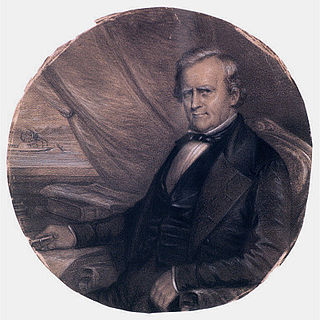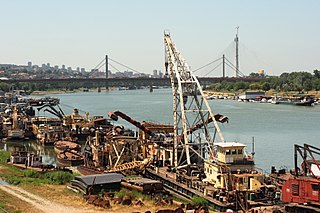Palace steamer is a term sometimes used to describe the largest and finest class of American passenger steamboats of their day. The term was used from almost the earliest era of American steam navigation, and continued to be employed up until at least the late 19th century.
The term was employed for steamboats in many parts of the United States, including the Great Lakes, the East Coast, the Hudson River and the Mississippi River, to name some of the more prominent regions.

A wherry is a type of boat that was traditionally used for carrying cargo or passengers on rivers and canals in England, and is particularly associated with the River Thames and the River Cam. They were also used on the Broadland rivers of Norfolk and Suffolk.

A steamboat is a boat that is propelled primarily by steam power, typically driving propellers or paddlewheels. The term steamboat is used to refer to small steam-powered vessels working on lakes, rivers, and in short-sea shipping. The development of the steamboat led to the larger steamship, which is a seaworthy and often ocean-going ship.

Henry Miller Shreve was an American inventor and steamboat captain who removed obstructions to navigation of the Mississippi, Ohio and Red rivers. Shreveport, Louisiana, was named in his honor.

Life on the Mississippi is a memoir by Mark Twain of his days as a steamboat pilot on the Mississippi River before the American Civil War published in 1883. It is also a travel book, recounting his trips on the Mississippi River, from St. Louis to New Orleans and then from New Orleans to Saint Paul, many years after the war.

The Ouachita River is a 605-mile-long (974 km) river that runs south and east through the U.S. states of Arkansas and Louisiana, joining the Tensas River to form the Black River near Jonesville, Louisiana. It is the 25th-longest river in the United States.

A riverboat is a watercraft designed for inland navigation on lakes, rivers, and artificial waterways. They are generally equipped and outfitted as work boats in one of the carrying trades, for freight or people transport, including luxury units constructed for entertainment enterprises, such as lake or harbour tour boats. As larger water craft, virtually all riverboats are especially designed and constructed, or alternatively, constructed with special-purpose features that optimize them as riverine or lake service craft, for instance, dredgers, survey boats, fisheries management craft, fireboats and law enforcement patrol craft.
Improvements to the steam engine were some of the most important technologies of the Industrial Revolution, although steam did not replace water power in importance in Britain until after the Industrial Revolution. From Englishman Thomas Newcomen's atmospheric engine, of 1712, through major developments by Scottish inventor and mechanical engineer James Watt, the steam engine began to be used in many industrial settings, not just in mining, where the first engines had been used to pump water from deep workings. Early mills had run successfully with water power, but by using a steam engine a factory could be located anywhere, not just close to a water source. Water power varied with the seasons and was not always available.

The term Mosquito Fleet has had a variety of naval and commercial uses around the world.

A keelboat is a riverine cargo-capable working boat, or a small- to mid-sized recreational sailing yacht. The boats in the first category have shallow structural keels, and are nearly flat-bottomed and often used leeboards if forced in open water, while modern recreational keelboats have prominent fixed fin keels, and considerable draft. The two terms may draw from cognate words with different final meaning.

The North River Steamboat or North River, colloquially known as the Clermont, is widely regarded as the world's first vessel to demonstrate the viability of using steam propulsion for commercial water transportation. Built in 1807, the North River Steamboat operated on the Hudson River – at that time often known as the North River – between New York City and Albany, New York. It was built by the wealthy investor and politician Robert Livingston and inventor and entrepreneur Robert Fulton (1765–1815).

Joseph Throckmorton was an American steamboat builder and captain during the 19th century. He was born in Monmouth County, New Jersey, and first worked in a mercantile business. His first steamboat was Red Rover, purchased on the Ohio River around 1830. In 1832 he built and skippered the steamboat Warrior. The vessel and Captain Throckmorton played a key role in the decisive battle of the 1832 Black Hawk War. Following the war, he built and owned several more steamboats, and worked for a short time as an insurance representative in St. Louis. Throckmorton died in December 1872 while employed by the United States government.

Many steamboats operated on the Columbia River and its tributaries, in the Pacific Northwest region of North America, from about 1850 to 1981. Major tributaries of the Columbia that formed steamboat routes included the Willamette and Snake rivers. Navigation was impractical between the Snake River and the Canada–US border, due to several rapids, but steamboats also operated along the Wenatchee Reach of the Columbia, in northern Washington, and on the Arrow Lakes of southern British Columbia.

The era of steamboats on the Arrow Lakes and adjoining reaches of the Columbia River is long-gone but was an important part of the history of the West Kootenay and Columbia Country regions of British Columbia Canada. The Arrow Lakes are formed by the Columbia River in southeastern British Columbia. Steamboats were employed on both sides of the border in the upper reaches of the Columbia, linking port towns on either side of the border, and sometimes boats would be built in one country and operated in the other. Tributaries of the Columbia include the Kootenay River which rises in Canada, then flows south into the United States, then bends north again back into Canada, where it widens into Kootenay Lake. As with the Arrow Lakes, steamboats once operated on the Kootenay River and Kootenay Lake.
Steamboats operated on the Wenatchee Reach of the Columbia River from the late 1880s to 1915. The main base of operations was Wenatchee, Washington, located at the confluence of the Wenatchee and Columbia Rivers, 465 miles (748 km) from the mouth of the river. Operations were mainly between Wenatchee and Bridgeport. Rapids below Wenatchee and above Bridgeport prevented safe navigation.

The sidewheeler Idaho was a steamboat that ran on the Columbia River and Puget Sound from 1860 to 1898. There is some confusion as to the origins of the name; many historians have proposed it is the inspiration for the name of the State of Idaho. Considerable doubt has been cast on this due to the fact that it is unclear if the boat was named before or after the idea of 'Idaho' as a territory name was proposed. John Ruckel also allegedly stated he had named the boat after a Native American term meaning 'Gem of the Mountains' he got from a mining friend from what is now Colorado territory. This steamer should not be confused with the many other vessels of the same name, including the sternwheeler Idaho built in 1903 for service on Lake Coeur d'Alene and the steamship Idaho of the Pacific Coast Steamship Line which sank near Port Townsend, Washington.

New Orleans was the first steamboat on the western waters of the United States. Her 1811–1812 voyage from Pittsburgh, Pennsylvania, to New Orleans, Louisiana, on the Ohio and Mississippi rivers ushered in the era of commercial steamboat navigation on the western and mid-western continental rivers.

Steamboats played a major role in the 19th-century development of the Mississippi River and its tributaries, allowing practical large-scale transport of passengers and freight both up- and down-river. Using steam power, riverboats were developed during that time which could navigate in shallow waters as well as upriver against strong currents. After the development of railroads, passenger traffic gradually switched to this faster form of transportation, but steamboats continued to serve Mississippi River commerce into the early 20th century. A small number of steamboats are still used for tourist excursions in the 21st century.

The Enterprise was an early steamboat operating on the Willamette River in Oregon and also one of the first to operate on the Fraser River in British Columbia. This vessel should not be confused with the many other vessels, some of similar design, also named Enterprise. In earlier times, this vessel was sometimes called Tom Wright's Enterprise after one of her captains, the famous Tom Wright.

A marine steam engine is a steam engine that is used to power a ship or boat. This article deals mainly with marine steam engines of the reciprocating type, which were in use from the inception of the steamboat in the early 19th century to their last years of large-scale manufacture during World War II. Reciprocating steam engines were progressively replaced in marine applications during the 20th century by steam turbines and marine diesel engines.

Joseph Marie LaBarge was an American steamboat captain, most notably of the steamboats Yellowstone, and Emilie, that saw service on the Mississippi and Missouri rivers, bringing fur traders, miners, goods and supplies up and down these rivers to their destinations. During much of his career LaBarge was in the employ of the American Fur Company, a giant in the fur trading business, before building his own steamboat, the Emilie, to become an independent riverman. During his career he exceeded several existing speed and distance records for steamboats on the Missouri River. Passengers aboard his vessels sometimes included notable people, including Abraham Lincoln. LaBarge routinely offered his steamboat services gratis to Jesuit missionaries throughout his career.